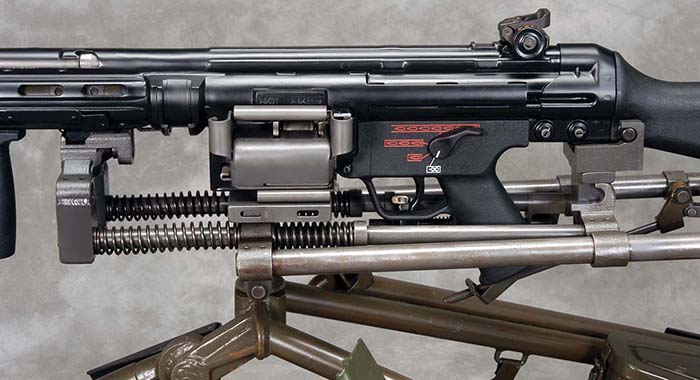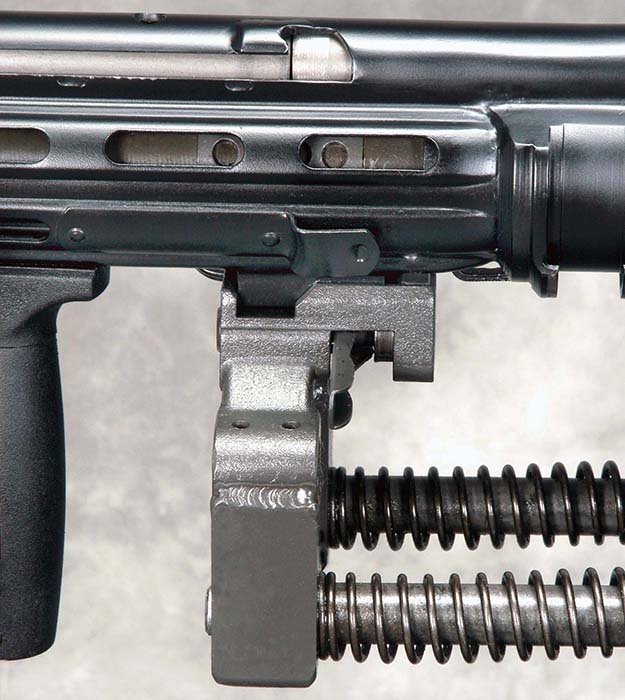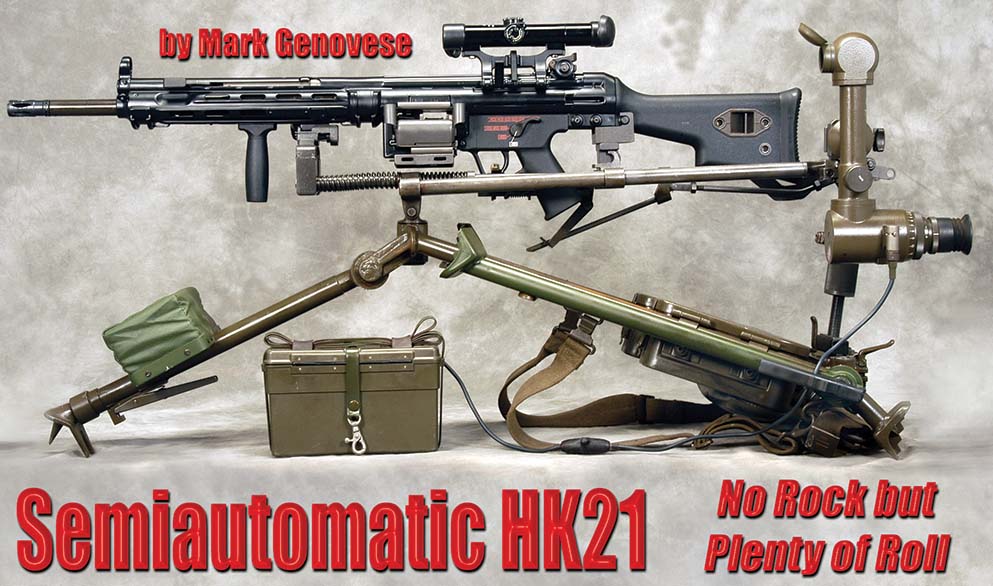by Mark Genovese
In reality, it was legitimate Class 2 manufacturers with the machinery, parts, personnel and know-how already in place who were in the best position to develop semiautomatic-only belt-fed guns from their full-auto derivatives. Two factors were involved in my acquisition of an HK21 semiautomatic-only. In 1984, I purchased an HK91A2 and was impressed with its obvious quality of manufacture. The second factor was the engineering shortcomings of my first semiautomatic-only belt-fed, the Rock Island Armory SA 1. Initially, there were only three companies producing semiautomatic-only belt-fed versions of full-auto originals. They were DLO in Arcadia, Florida with their line of Browning belt-fed guns; Rock Island Armory in Colona, Illinois with the SA 1 version of the M60; and Vollmer Manufacturing of Bloomington, Illinois with a fine semiautomatic-only copy of the HK21. Several years later, Valkyrie Arms in Olympia, Washington, started marketing its great semiautomatic version of the M1919A4 Browning gun.
What the general shooting and collecting public do not know about these complex semiautomatic-only firearms is what it takes to legally bring them to market. The fusillade of BATF rules and regulations forced on the prospective manufacture can be mind-boggling, beginning with “Once a machine gun always a machine gun”. This means that you cannot take a post sample HK21, torch cut the receiver three times as prescribed by the BATF (because in this case it would include the push-in feed box), then assemble these cut parts on a pre-ban HK91 rifle receiver. If you doubt my words, buy a HK21 kit for $1,795 and you tell me how you’re going to re-weld the push-in feed box when there is none. How then did Vollmer Manufacturing make their semiautomatic-only HK21guns? They traveled to the HK-licensed INDEP SA factory in Portugal, negotiated, purchased and imported the unassembled component HK21 parts in the white. Because the parts were never a live machine gun, Vollmer, with BATF approval in writing, was permitted to build their semiautomatic-only HK21 on pre-ban HK91 rifle receivers.

There would, however, be more hoops for Vollmer and their engineering crew to jump through. BATF regulations state that you cannot remove a firearm’s serial number. If you look at where the H&K 91’s serial number is, you will see it is dead center over the push-in feed mechanism unit. Because of the innovative design genius of Terry Dyer, an employee of Vollmer at the time, they overcame this hurdle by cutting away the magazine-well sheet metal to the right and left of the serial number leaving this centerpiece in a straight sheet. Then, it was carefully folded up once and back down accordion style while still attached to the HK91 receiver. This was neatly welded into place up and out of the way of the feed box. It was then finished to provide a raised plaque appearance. All this was completed with prior BATF written approvals. Subsequently came the arduous task of fitting the welding jigs to properly assemble all the parts onto the semiautomatic-only HK91 receiver in accordance with original factory specifications. For all of you that recently purchased a torch-cut HK21 kit with the desire to have it built into a working semiautomatic-only, all is not lost. Although, in reality your chances are slim at best to build a truly legal semiautomatic-only HK21, you could in theory still put together a very exotic HK21 semiautomatic-only, or a Model 11 or the Model 13 in 5.56x45mm (similar to the HK91 but has the trunnion, barrel shroud and quick-change heavy barrel from the HK21). A nice feature of the Vollmer HK21 is that you can easily convert it to magazine-feed by removing all three pieces of the belt-feed mechanism and replace it with a magazine adapter. One sells for about $250, but it will not fit in a Vollmer HK21 without two holes being milled in the receiver. Keep in mind that this work would be a permanent alteration to the receiver, requiring prior BATF written approval. The other adapter is the very rare original HK21 accessory, which will fit perfectly, but will set you back about $750 (mine is marked “HK21 483 11/71”). You will have to change the H&K 21 double-wound recoil spring for the weaker HK91 spring. You will also need a complete HK91 bolt and carrier because the HK21 carrier has an offset belt-feed mechanism slot which will impinge against the inside of the magazine-feed lips, resulting in a failure to strip a round. I was able to avoid the purchase of the HK91 bolt group by slowly stoning the inside of both feed lips. Be careful, it you take off too much material the magazine will not retain the 7.62x51mm cartridge.

On the subject of interchangeability of parts for the Vollmer H&K 21, in various firearms publications, you will find from time to time HK21 barrels selling for around $300 each. They can be German marked “HK” or Portuguese marked “FMP”. The chances are that neither will fully lock up in your Vollmer HK21, and if it does, take a good look at your headspace, as it’s probably not correct. The same goes for the links used to feed the HK21. Everything you will read about this firearm states the 21 is capable of digesting DM13 and M13 disintegrating link belts or DM1 non-disintegrating link belts. After much experimentation, skinned knuckles and UPS deliveries, I can state with authority, the continuous belts definitely do not run in my HK21. You will also read everywhere the HK21 can – by changing the barrel, cartridge guide, belt feed insertion unit and bolt – be converted to fire 5.56x45mm or 7.62x39mm cartridges. Let me let you in on a little secret: your chances of purchasing these HK21 parts are one in a billion, especially the 7.62x39mm. I have heard of sightings on occasion of HK21 barrels in caliber 5.56x45mm and once of a 5.56x45mm HK21 bolt head. But until I see it with my own eyes, it’s all talk. There was a purpose-built, extremely light tripod Model L012 with optical periscope sight. These are as easy to get as the 7.62x39mm conversion parts. I once heard one was selling for $2,500.
I got around this one by purchasing a FN Model 30 tripod made of lightweight titanium alloy, shipping it to TDyer Gunsmith and Machine Shop (Dept. SAR, RR#2, Box 119, Heyworth, IL 61745; phone: 309-473-3377; email: tdyer@mindspring.com) for a complete rebuild, including H&K black finish. Terry offers a beautifully machined set of adaptors that fit in the bipod shroud slots to the mount. This is the Cadillac of the German Bundeswehr for the MG3 series machine gun, commonly referred to as the MG3 mount. Just last year this set-up would cost you up to $2,500. Supply and demand has changed that. I picked one up last week for under $600, delivered brand-new. In order to fit the HK21, you will need some serious machine work done to the recoiling head. It must be lowered to clear the HK21 feed tray. TDyer Gunsmith and Machine Shop offers his outstanding conversion on a limited basis.

I fully understand that there are people out there who would purchase one of these fine firearms never intending to actually shoot it though I am not one. As far as I’m concerned, burn the paint right off it. Get the barrel so hot, you need an ice pack just to look at it. Definitely put it through its paces. You will feel better in the morning. In my case after about 5,000 rounds of Czech black primer ZV69, things started to get loud and the 4-foot-long muzzle flash aroused my curiosity. When the cocking lever disappeared down range, I figured it was time to check the headspace, there was none. It was absolutely paint and tune-up time. Off it went to Terry’s shop so he could do his magic. I decided to go the whole nine yards. First repair the headspace problem, not as easy as it may sound. In this case it would require stripping the gun completely to the trunnion, replacing it, then rebuilding from the ground up. Second, fit and headspace a spare second barrel and serialize both to the gun. We also decided to smooth out the recoil. This would require a factory long (often called a “E” or Dutch Buffer) buffer. This part is 1 3/8 inches longer than the stock part, meaning the cocking slot would have to move forward by that amount or you would not be able to lock the bolt in the open position. He also reinforced the lock slot with extra material. Then I had the receiver and both barrels cryogenic treated for hardness, fit a new FBI ambidextrous single-fire trigger group, plus a half a dozen other small details. It was worth the wait.
| This article first appeared in Small Arms Review V7N12 (September 2004) |











